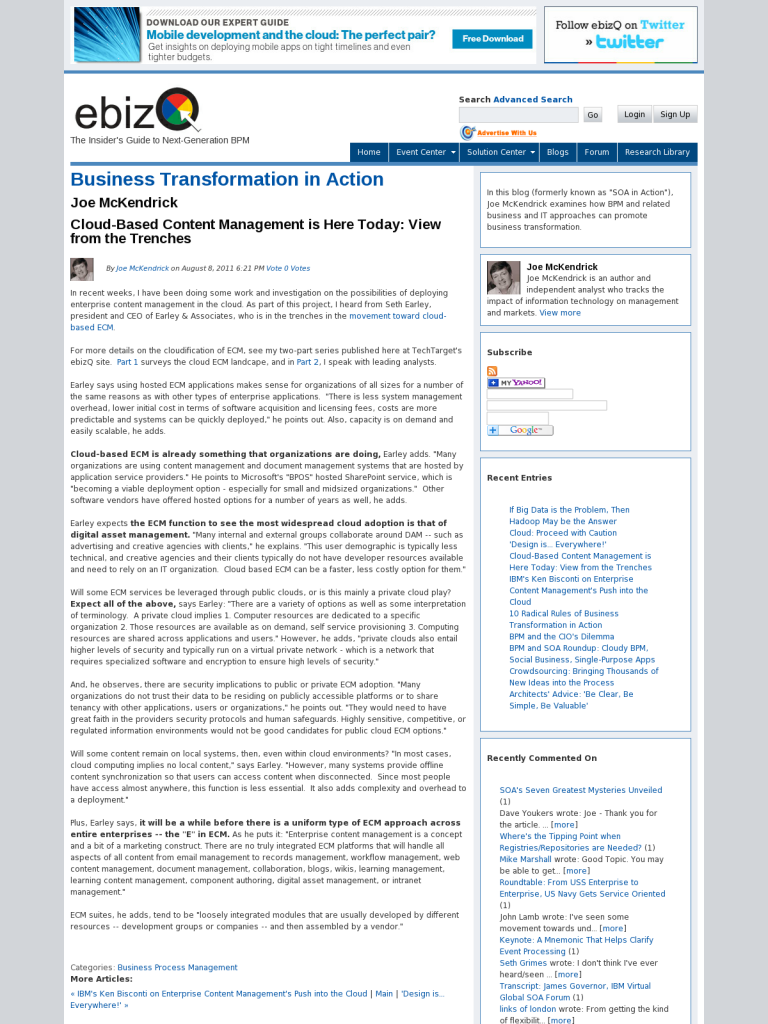Cloud-Based Content Management is Here Today: View from the Trenches
In recent weeks, I have been doing some work and investigation on the possibilities of deploying enterprise content management in the cloud. As part of this project, I heard from Seth Earley, president and CEO of Earley & Associates, who is in the trenches in the movement toward cloud-based ECM.
For more details on the cloudification of ECM, see my two-part series published here at TechTarget’s ebizQ site. Part 1 surveys the cloud ECM landcape, and in Part 2, I speak with leading analysts.
Earley says using hosted ECM applications makes sense for organizations of all sizes for a number of the same reasons as with other types of enterprise applications. “There is less system management overhead, lower initial cost in terms of software acquisition and licensing fees, costs are more predictable and systems can be quickly deployed,” he points out. Also, capacity is on demand and easily scalable, he adds.
Cloud-based ECM is already something that organizations are doing, Earley adds. “Many organizations are using content management and document management systems that are hosted by application service providers.” He points to Microsoft’s “BPOS” hosted SharePoint service, which is “becoming a viable deployment option – especially for small and midsized organizations.” Other software vendors have offered hosted options for a number of years as well, he adds.
Earley expects the ECM function to see the most widespread cloud adoption is that of digital asset management. “Many internal and external groups collaborate around DAM — such as advertising and creative agencies with clients,” he explains. “This user demographic is typically less technical, and creative agencies and their clients typically do not have developer resources available and need to rely on an IT organization. Cloud based ECM can be a faster, less costly option for them.”
Will some ECM services be leveraged through public clouds, or is this mainly a private cloud play? Expect all of the above, says Earley: “There are a variety of options as well as some interpretation of terminology. A private cloud implies 1. Computer resources are dedicated to a specific organization 2. Those resources are available as on demand, self service provisioning 3. Computing resources are shared across applications and users.” However, he adds, “private clouds also entail higher levels of security and typically run on a virtual private network – which is a network that requires specialized software and encryption to ensure high levels of security.”
And, he observes, there are security implications to public or private ECM adoption. “Many organizations do not trust their data to be residing on publicly accessible platforms or to share tenancy with other applications, users or organizations,” he points out. “They would need to have great faith in the providers security protocols and human safeguards. Highly sensitive, competitive, or regulated information environments would not be good candidates for public cloud ECM options.”
Will some content remain on local systems, then, even within cloud environments? “In most cases, cloud computing implies no local content,” says Earley. “However, many systems provide offline content synchronization so that users can access content when disconnected. Since most people have access almost anywhere, this function is less essential. It also adds complexity and overhead to a deployment.”
Plus, Earley says, it will be a while before there is a uniform type of ECM approach across entire enterprises — the “E” in ECM. As he puts it: “Enterprise content management is a concept and a bit of a marketing construct. There are no truly integrated ECM platforms that will handle all aspects of all content from email management to records management, workflow management, web content management, document management, collaboration, blogs, wikis, learning management, learning content management, component authoring, digital asset management, or intranet management.”
ECM suites, he adds, tend to be “loosely integrated modules that are usually developed by different resources — development groups or companies — and then assembled by a vendor.”
Leave a Comment
You must be logged in to post a comment.








